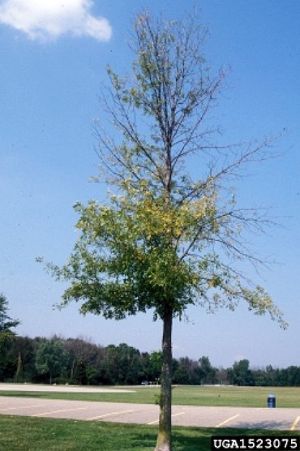 Fall is a good time to cut down diseased and dying trees so I was not surprised when Tony Bledsoe told me he saw a diseased ash tree being cut down at Pitt’s campus. When he mentioned the location, I remembered seeing a tree there that looked like this one dying of emerald ash borer (EAB).
Fall is a good time to cut down diseased and dying trees so I was not surprised when Tony Bledsoe told me he saw a diseased ash tree being cut down at Pitt’s campus. When he mentioned the location, I remembered seeing a tree there that looked like this one dying of emerald ash borer (EAB).
Emerald ash borer is present in Allegheny County and is becoming the scourge of our ash trees. The larvae of this pest burrow under the bark and eat through the tree’s vascular system. After a tree becomes infected it dies in 1-3 years.
Tony and I both wondered if the tree at Pitt was afflicted with EAB and if so, how the tree company could prevent the spread of this dangerous bug. Can the waste wood be burned? Can it be sold as lumber? Can it be dumped at a yard debris site?
I asked Steve Miller of Bartlett Tree Experts, a Board Certified Master Arborist whom I met at an urban tree tending workshop. He told me there are rules about wood transport and best practices for wood management.
The rules are that Allegheny County and a large part of western Pennsylvania are in a wood transport quarantine zone. We must not transport firewood because it could spread EAB to uninfected areas. The waste wood probably won’t be sold as lumber because it’s damaged and it’s from a quarantine zone.
The recommended way to dispose of EAB-infested trees is by chipping, burial or burning, but the wood should not be stored as firewood through the winter months. The larvae are hiding under the bark.
If you have a diseased tree in your yard, be careful what you do with it. The important thing is to know what you’re looking at. Is it an ash tree? It is afflicted with emerald ash borer? Is it time for the ax?
Get good advice. Ask an arborist.
(photo from Pennsylvania DCNR’s EAB website. Click the photo to see it in its original context.)